Effect of Cr Addition on Magnetic Properties and Corrosion Resistance of Optimized Co and Fe-Based Amorphous Alloys
Abstract
1. Introduction
2. Materials and Methods
3. Results & Discussion
4. Conclusions
Author Contributions
Funding
Data Availability Statement
Conflicts of Interest
References
- Shen, B.L.; Inoue, A. Superhigh strength and good soft-magnetic properties of (Fe,Co)–B–Si–Nb bulk glassy alloys with high glass-forming ability. Appl. Phys. Lett. 2004, 85, 4911–4913. [Google Scholar] [CrossRef]
- Pang, S.J.; Zhang, T. Bulk glassy Fe–Cr–Mo–C–B alloys with high corrosion resistance. Corros. Sci. 2002, 44, 1847–1856. [Google Scholar] [CrossRef]
- Inoue, A.; Makino, A. Ferromagnetic bulk glassy alloys. J. Magn. Magn. Mater. 2000, 246, 215–216. [Google Scholar] [CrossRef]
- Botta, W.J.; Berger, J.E. Corrosion resistance of Fe-based amorphous alloys. J. Alloys Compd. 2014, 586, S105–S110. [Google Scholar] [CrossRef]
- Virtranen, S.; Boehni, H. High Corrosion Resistance of Amorphous Fe-Cr-P Alloys. ISIJ Int. 1991, 31, 229–232. [Google Scholar] [CrossRef]
- Tan, M.W.; Akiyama, E. Change in the surface composition of amorphous Fe-Cr-Mo-P-C alloys during air exposure. Corros. Sci. 1995, 37, 331–341. [Google Scholar] [CrossRef]
- Long, Z.L.; Shao, Y. Cr effects on magnetic and corrosion properties of Fe–Co–Si–B–Nb–Cr bulk glassy alloys with high glass-forming ability. Intermetallics 2007, 15, 1453–1458. [Google Scholar] [CrossRef]
- Wang, S.L.; Li, H.X. Effects of Cr contents in Fe-based bulk metallic glasses on the glass forming ability and the corrosion resistance. Mater. Chem. Phys. 2009, 113, 878–883. [Google Scholar] [CrossRef]
- Shen, B.; Akiba, M. Excellent soft-ferromagnetic bulk glassy alloys with high saturation magnetization. Appl. Phys. Lett. 2006, 88, 131907. [Google Scholar] [CrossRef]
- Inoue, A.; Shinohara, Y. Thermal and Magnetic Properties of Bulk Fe-Based Glassy Alloys Prepared by Copper Mold Casting. Mater. Trans. JIM 1995, 36, 1427–1433. [Google Scholar] [CrossRef]
- Gopalan, R.; Chen, Y.M. High saturation magnetization and microstructure in melt-spun Fe–P ribbons. Scr. Mater. 2009, 61, 544–547. [Google Scholar] [CrossRef]
- Jayaraj, J.; Kim, K.B. Corrosion mechanism of N-containing Fe–Cr–Mo–Y–C–B bulk amorphous alloys in highly concentrated HCl solution. Mater. Sci. Eng. A 2007, 449–451, 517–520. [Google Scholar] [CrossRef]
- Suryanarayana, C.; Inoue, A. Iron-based bulk metallic glasses. Int. Mater. Rev. 2013, 58, 131–166. [Google Scholar] [CrossRef]
- Kim, S.; Han, B. Optimization of Fe/Co ratio in Fe(87-x-y)CoxTi7Zr6By alloys for high saturation magnetization. Curr. Appl. Phys. 2016, 16, 515–519. [Google Scholar] [CrossRef]
- Fujimori, H.; Kikuchi, M. On the Magnetization Process in an Iron-Phosphorus-Carbon Amorphous Ferromagnet. J. Appl. Phys. 1974, 13, 1889. [Google Scholar] [CrossRef]
- Wang, J.; Wang, Z. High temperature soft magnetic properties of (FexCo1−x)73.5Cu1Mo3Si13.5B9 (x = 0.5,1) alloys. J. Magn. Magn. Mater. 2013, 328, 62. [Google Scholar] [CrossRef]
- Inomata, K.; Hasehawa, M. Magnetic properties of amorphous Fe-Cr-Si-B alloys. IEEE Trans. Mag. 1981, 17, 3076. [Google Scholar] [CrossRef]
- Kim, S.; Choi-Yim, H. Effect of iron on the thermal and the magnetic properties for cobalt-based amorphous alloys. JKPS. 2015, 67, 2120–2123. [Google Scholar] [CrossRef]
- Oh, J.; Choi-Yim, H. Thermal and magnetic properties of the Co-Fe-B-Si-Ta alloy system for several Fe/Co ratios. J. Korean Phy. Soc. 2016, 69, 1813–1816. [Google Scholar] [CrossRef]
- Zhang, J.; Chang, C. Development of quaternary Fe-based bulk metallic glasses with high saturation magnetization above 1.6 T. J. Non-Cryst. Solid 2012, 358, 1443–1446. [Google Scholar] [CrossRef]
- Inoue, A.; Katsuya, A. Multicomponent Co-based Amorphous Alloys with Wide Supercooled Liquid Region. Mater. Trans. JIM 1996, 37, 1332–1336. [Google Scholar] [CrossRef][Green Version]
- Yamasaki, T.; Maeda, S. Viscosity measurements of Zr55Cu30Al10Ni5 supercooled liquid alloys by using penetration viscometer under high-speed heating conditions. Intermetallics. 2006, 14, 1102. [Google Scholar] [CrossRef]
- Schwarz, R.B.; Sen, T.D. Soft ferromagnetism in amorphous and nanocrystalline alloys. J. Magn. Magn. Mater. 2004, 283, 223–230. [Google Scholar] [CrossRef]
- Bas, A.D.; Ghali, E. A review on electrochemical dissolution and passivation of gold during cyanidation in presence of sulphides and oxides. Hydrometallurgy 2017, 172, 30–44. [Google Scholar] [CrossRef]

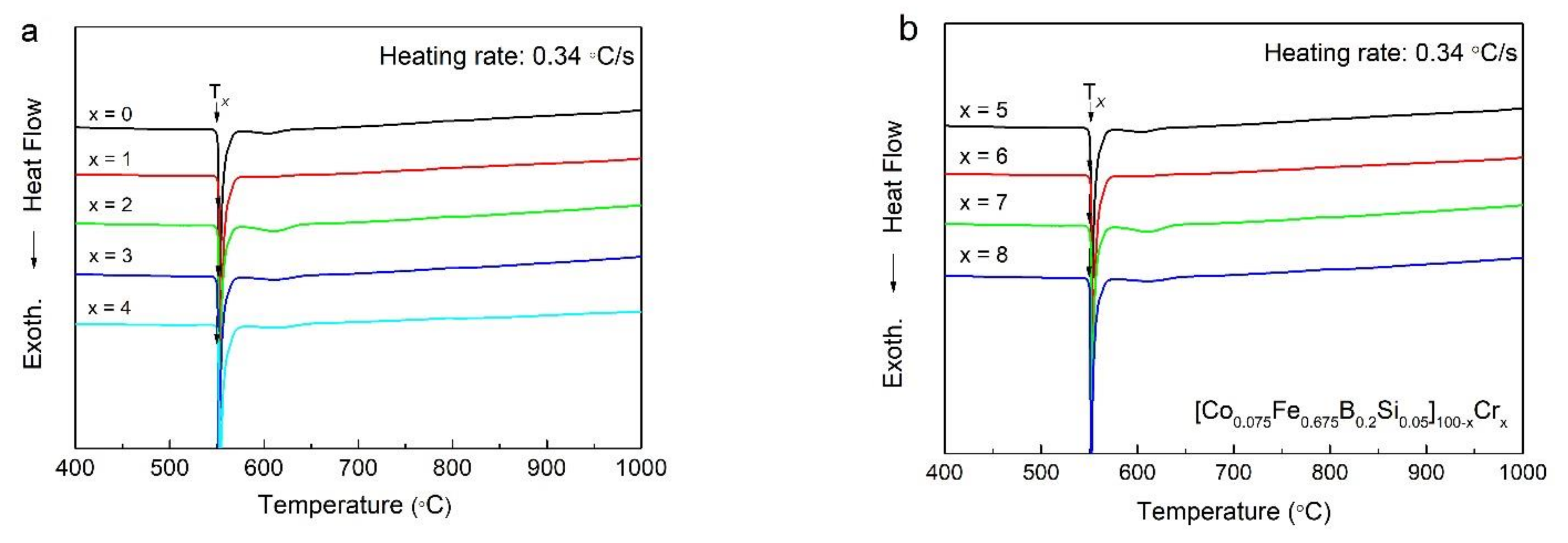
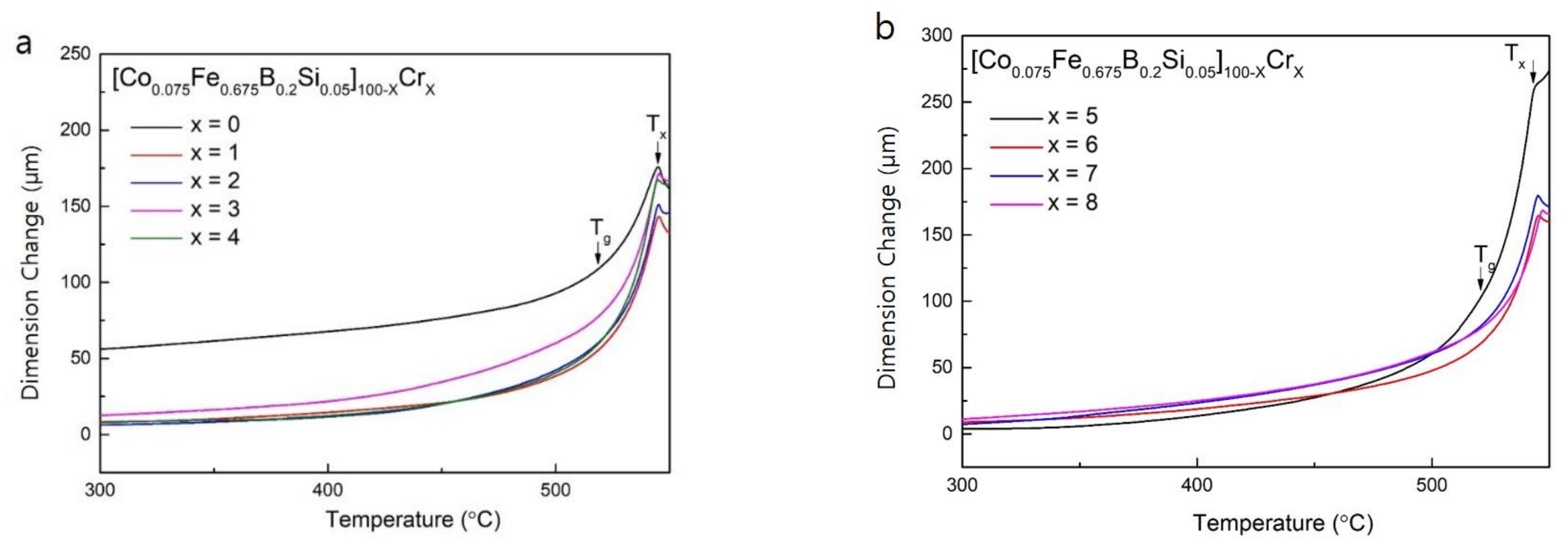
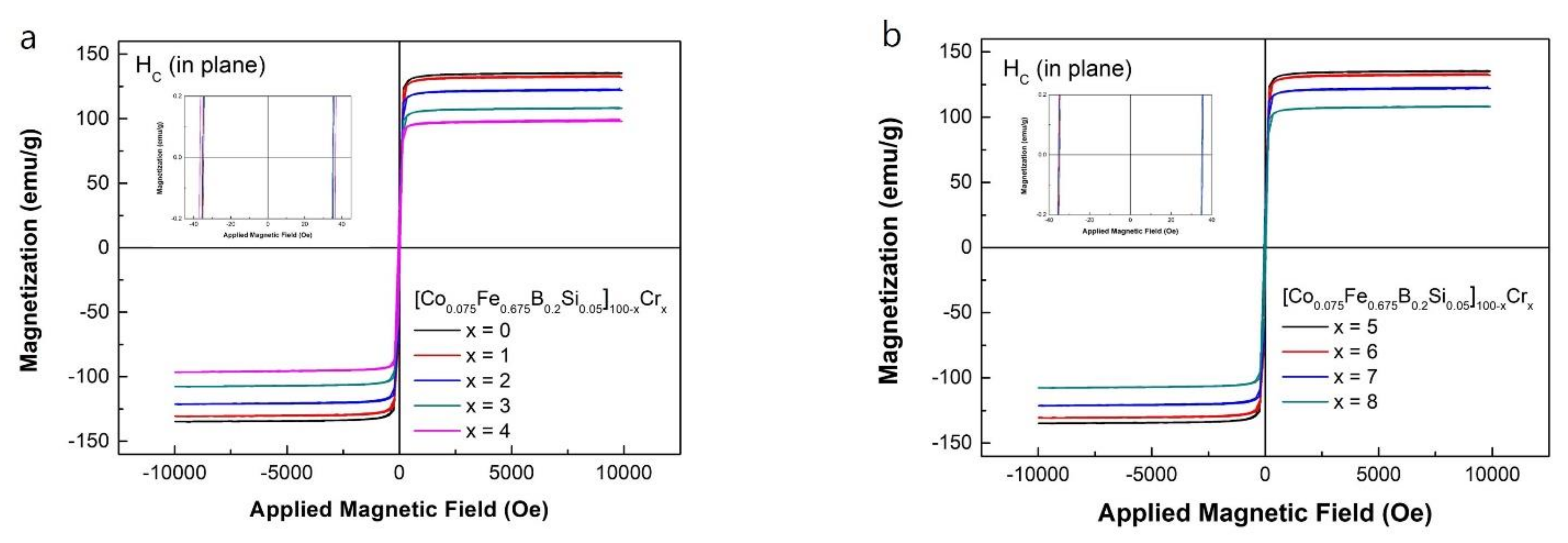
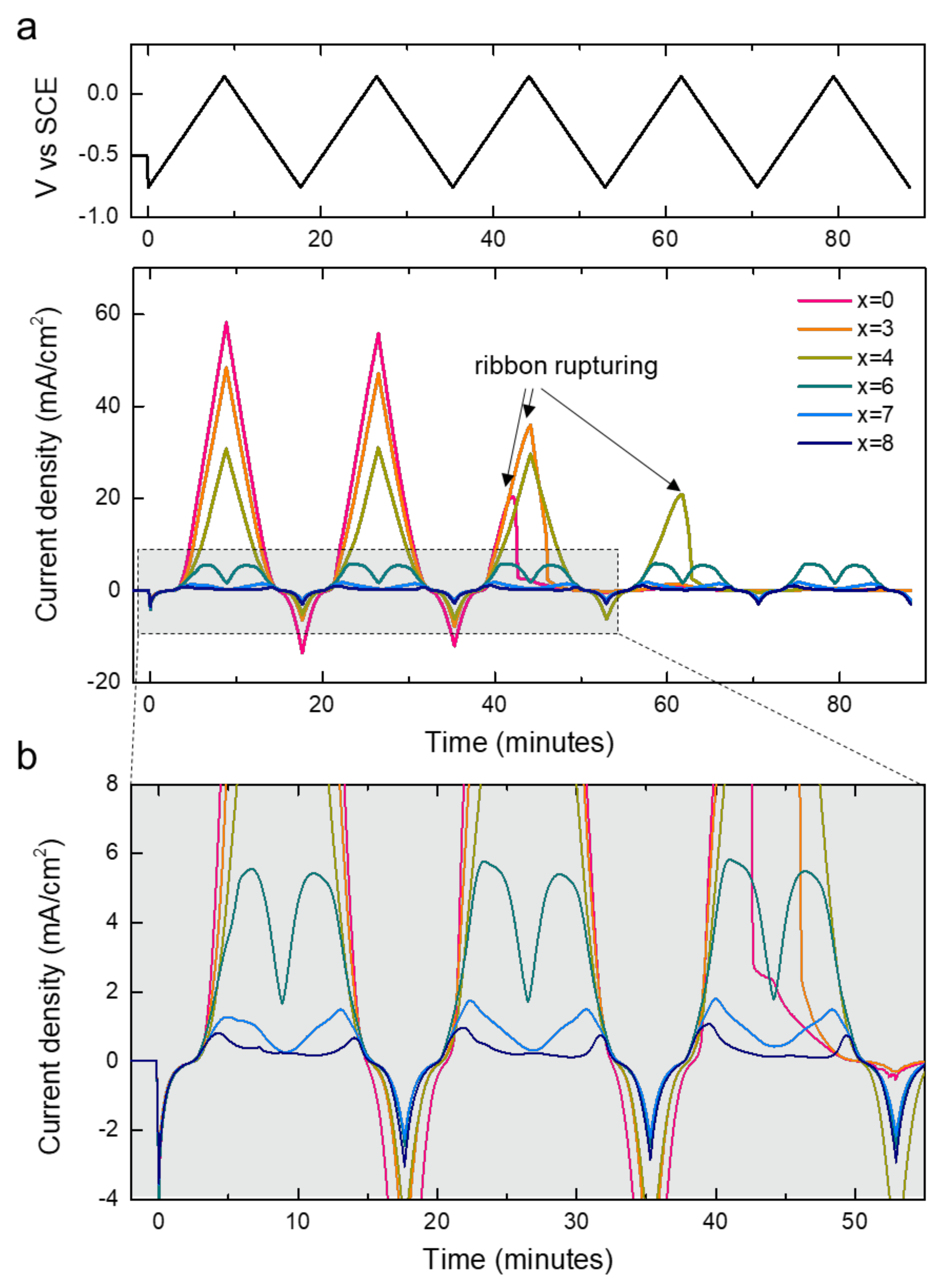
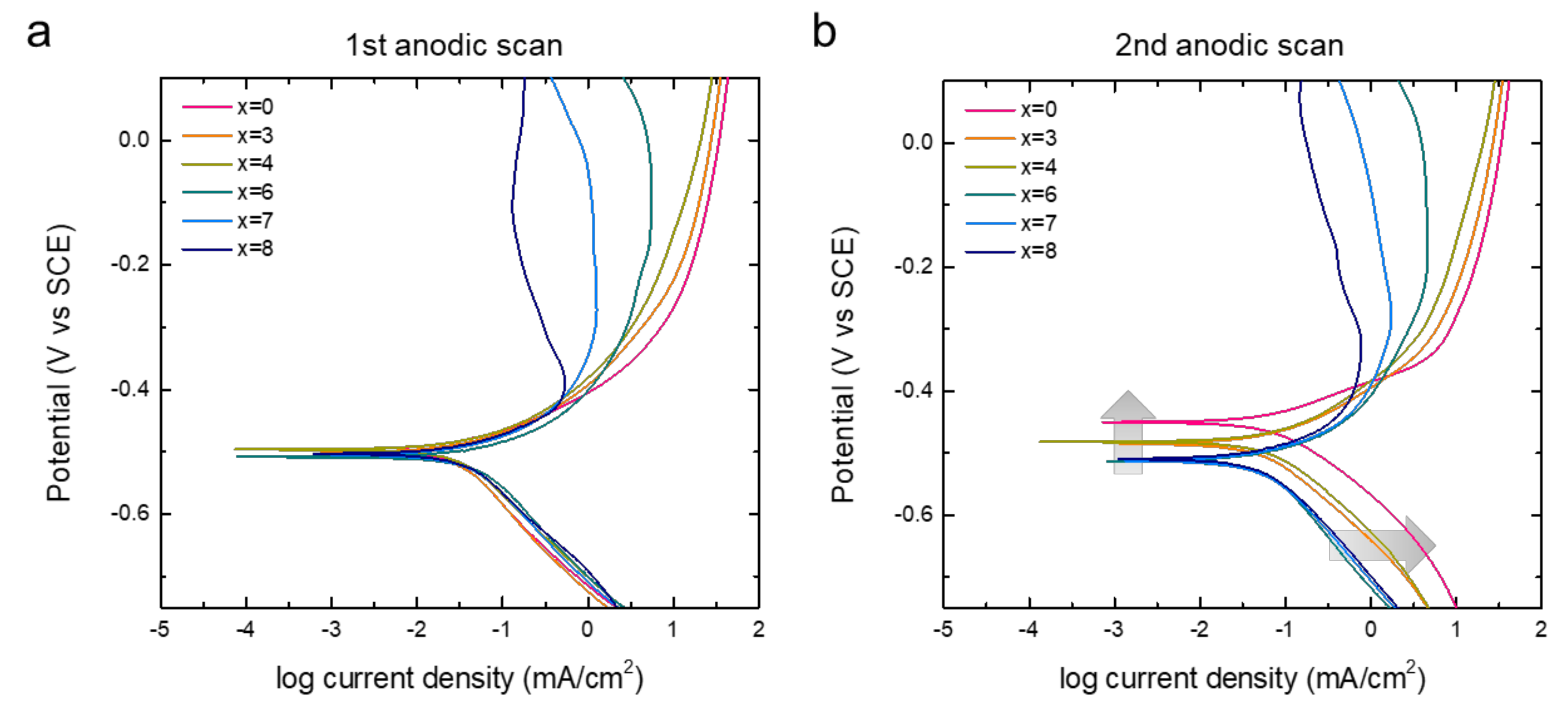
| x | [Co0.075Fe0.675B0.2Si0.05]100−xCrx | Tx,DSC (°C) |
|---|---|---|
| 0 | [Co0.075Fe0.675B0.2Si0.05]100 | 546.4 |
| 1 | [Co0.075Fe0.675B0.2Si0.05]99Cr1 | 547.7 |
| 2 | [Co0.075Fe0.675B0.2Si0.05]98Cr2 | 548.3 |
| 3 | [Co0.075Fe0.675B0.2Si0.05]97Cr3 | 546.8 |
| 4 | [Co0.075Fe0.675B0.2Si0.05]96Cr4 | 546.8 |
| 5 | [Co0.075Fe0.675B0.2Si0.05]95Cr5 | 548.2 |
| 6 | [Co0.075Fe0.675B0.2Si0.05]94Cr6 | 548.7 |
| 7 | [Co0.075Fe0.675B0.2Si0.05]93Cr7 | 548.2 |
| 8 | [Co0.075Fe0.675B0.2Si0.05]92Cr8 | 547.4 |
| x | [Co0.075Fe0.675B0.2Si0.05]100-xCrx | Tx, TMA (°C) | Tg (°C) | ΔTx (°C) |
|---|---|---|---|---|
| 0 | [Co0.075Fe0.675B0.2Si0.05]100 | 544.92 | 518.06 | 26.86 |
| 1 | [Co0.075Fe0.675B0.2Si0.05]99Cr1 | 545.06 | 522.65 | 22.41 |
| 2 | [Co0.075Fe0.675B0.2Si0.05]98Cr2 | 544.97 | 523.38 | 21.59 |
| 3 | [Co0.075Fe0.675B0.2Si0.05]97Cr3 | 545.09 | 523.03 | 22.06 |
| 4 | [Co0.075Fe0.675B0.2Si0.05]96Cr4 | 544.19 | 524.68 | 19.51 |
| 5 | [Co0.075Fe0.675B0.2Si0.05]95Cr5 | 543.23 | 521.91 | 21.32 |
| 6 | [Co0.075Fe0.675B0.2Si0.05]94Cr6 | 544.86 | 524.39 | 20.47 |
| 7 | [Co0.075Fe0.675B0.2Si0.05]93Cr7 | 544.76 | 522.46 | 22.30 |
| 8 | [Co0.075Fe0.675B0.2Si0.05]92Cr8 | 546.77 | 524.25 | 22.52 |
| x | [Co0.075Fe0.675B0.2Si0.05]100−xCrx | ρ (g/cm3) | Ms | |
|---|---|---|---|---|
| emu/g | T | |||
| 0 | [Co0.075Fe0.675B0.2Si0.05]100 | 6.69 | 182.09 | 1.53 |
| 1 | [Co0.075Fe0.675B0.2Si0.05]99Cr1 | 6.70 | 168.09 | 1.42 |
| 2 | [Co0.075Fe0.675B0.2Si0.05]98Cr2 | 6.70 | 159.29 | 1.34 |
| 3 | [Co0.075Fe0.675B0.2Si0.05]97Cr3 | 6.71 | 153.89 | 1.30 |
| 4 | [Co0.075Fe0.675B0.2Si0.05]96Cr4 | 6.71 | 148.97 | 1.26 |
| 5 | [Co0.075Fe0.675B0.2Si0.05]95Cr5 | 6.72 | 137.72 | 1.16 |
| 6 | [Co0.075Fe0.675B0.2Si0.05]94Cr6 | 6.72 | 133.54 | 1.13 |
| 7 | [Co0.075Fe0.675B0.2Si0.05]93Cr7 | 6.73 | 121.12 | 1.02 |
| 8 | [Co0.075Fe0.675B0.2Si0.05]92Cr8 | 6.73 | 110.23 | 0.93 |
Publisher’s Note: MDPI stays neutral with regard to jurisdictional claims in published maps and institutional affiliations. |
© 2021 by the authors. Licensee MDPI, Basel, Switzerland. This article is an open access article distributed under the terms and conditions of the Creative Commons Attribution (CC BY) license (http://creativecommons.org/licenses/by/4.0/).
Share and Cite
Han, J.; Hong, J.; Kwon, S.; Choi-Yim, H. Effect of Cr Addition on Magnetic Properties and Corrosion Resistance of Optimized Co and Fe-Based Amorphous Alloys. Metals 2021, 11, 304. https://doi.org/10.3390/met11020304
Han J, Hong J, Kwon S, Choi-Yim H. Effect of Cr Addition on Magnetic Properties and Corrosion Resistance of Optimized Co and Fe-Based Amorphous Alloys. Metals. 2021; 11(2):304. https://doi.org/10.3390/met11020304
Chicago/Turabian StyleHan, Jonghee, Jihyun Hong, Seoyeon Kwon, and Haein Choi-Yim. 2021. "Effect of Cr Addition on Magnetic Properties and Corrosion Resistance of Optimized Co and Fe-Based Amorphous Alloys" Metals 11, no. 2: 304. https://doi.org/10.3390/met11020304
APA StyleHan, J., Hong, J., Kwon, S., & Choi-Yim, H. (2021). Effect of Cr Addition on Magnetic Properties and Corrosion Resistance of Optimized Co and Fe-Based Amorphous Alloys. Metals, 11(2), 304. https://doi.org/10.3390/met11020304






